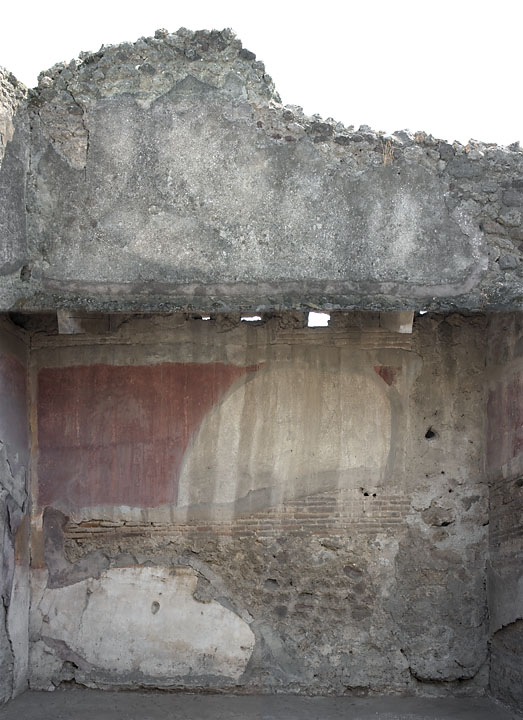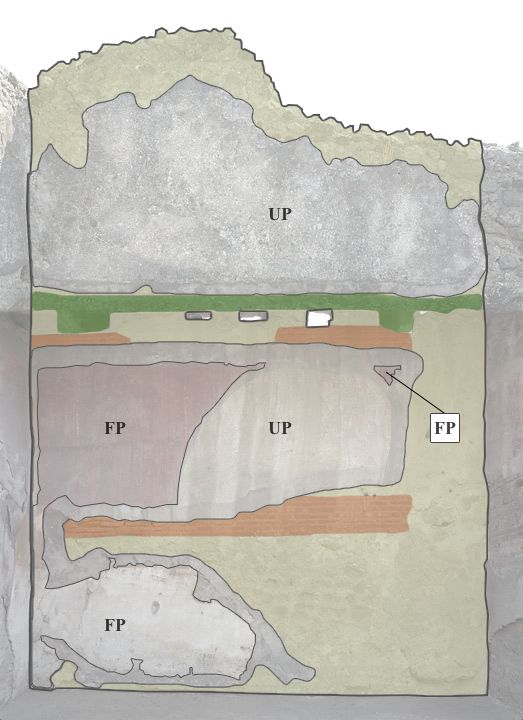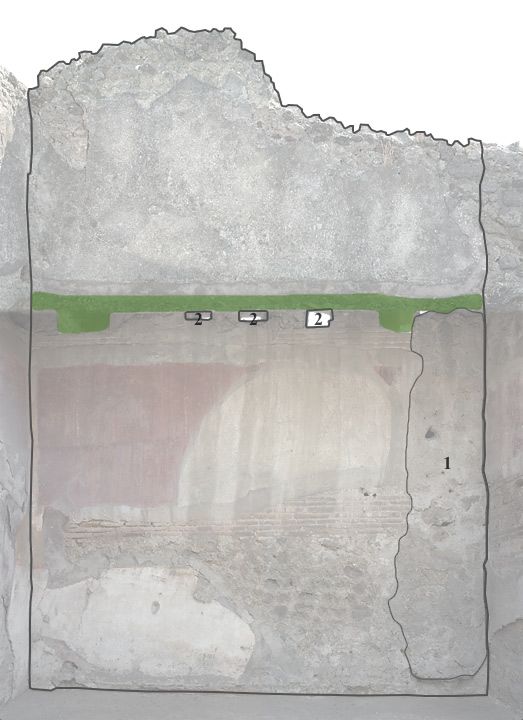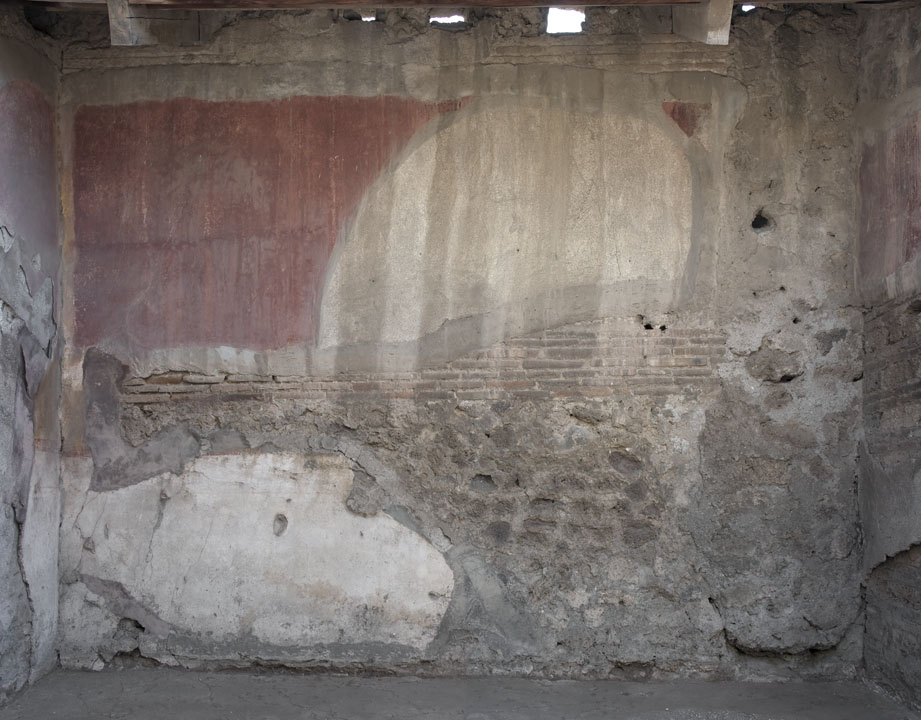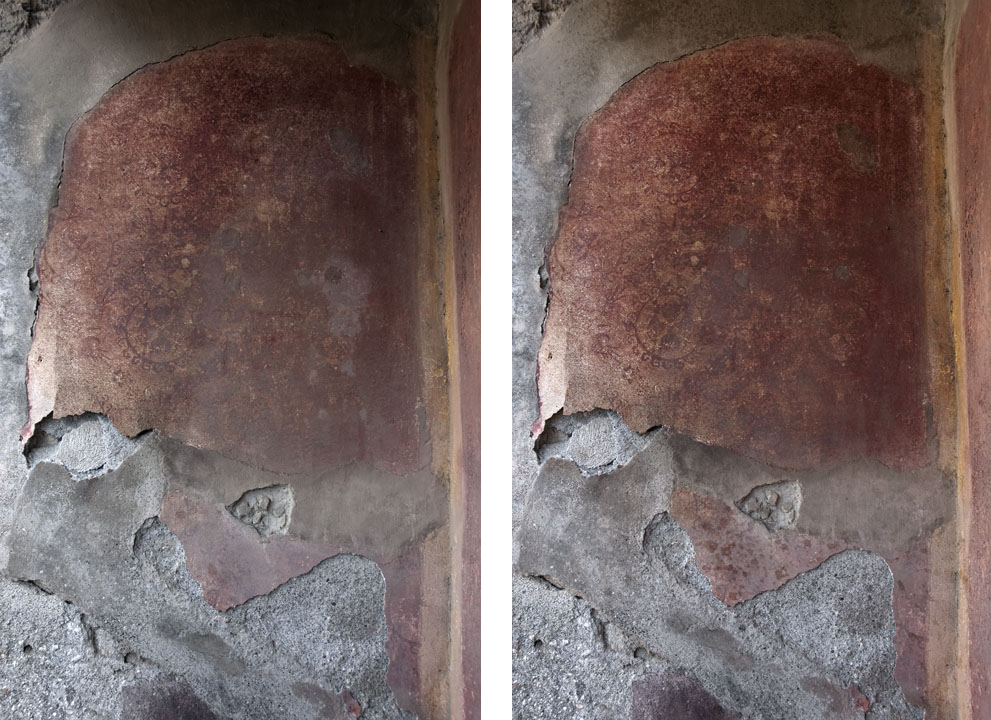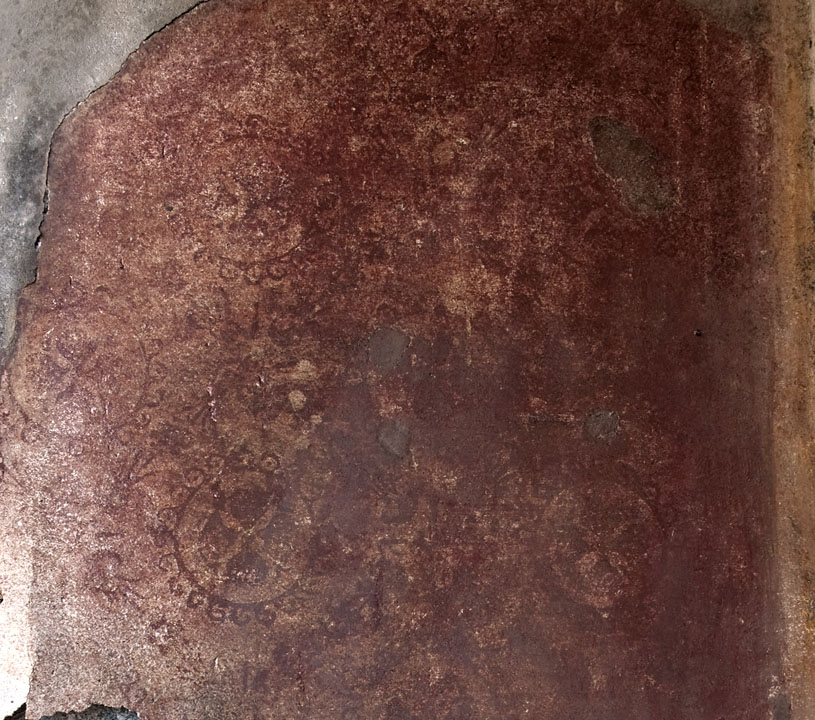South Wall
Description
Mats Holmlund
Ground floor
The wall is built in opus mixtum. It’s 3.90 m wide and 3.10 (west corner) to 3.20 (east corner) m high. From the floor up until circa 1.30 m, the wall is built in opus incertum and consists of limestone, lava and cruma. Between 1.30 and 1.60 m from the floor, the wall is built in opus testaceum. It consists of seven rows of tiles, which vary in size, thickness and colour. From 1.60 to 2.70 m the construction method is opus incertum again, but since plaster and modern repairs mainly cover that part of the wall, the technique is only visible from room 6 in taberna V.1,1.32. Above the second incertum segment, there’s yet another row of tiles that’s circa 0.30 m in height and consist of four tiers.
In the west corner there’s a repaired breach in the wall. It’s circa 0.60 to 0.70 m wide and starts 0.10 m above the floor, and stretches up to the beam holes. The repair is made up of reused limestone and cruma, but also contains some pieces of lava, plaster and tile. Above the second row of tiles, at circa 3.00 m above the floor, there’s a row of beam holes for the upper floor and a (modern) protective roof, that’s been built to protect the remaining plaster of the wall. There are no signs of spolia in the wall (except for some reused material in the repaired breach).
The mortar of the incertum and testaceum parts of the wall is yellowish grey and contains grains of lava, limestone and (some) terracotta. The mortar of the repaired breach varies in colour from light grey to brownish grey and seems to have been applied at various occasions.
The remaining wall plaster is divided into two large areas that are connected via a circa 0.12 m wide strip at the east corner of the wall. The first (lower) area is approximately 1.80 m wide and 1.05 m high. It stretches up from the floor and westwards from the east corner, and is partly held in place by bands of modern, pinkish grey and plain grey mortar. Since the modern mortar is of two different kinds, it seems likely that it has been applied to the wall and plaster at, at least, two different times. The first area of plaster is mainly white, but contains traces of a yellow decorative band and another red band that separates the socle zone from the middle zone of the wall painting. The yellow decorative band is 0.05 m wide and its bottom is located circa 0.80 m above the floor. The red band is also 0.05 m wide and its lower edge is located approximately 1.00 m above the floor.
The second area of plaster is mainly red and stretches from the eastern corner. At its lowest part it’s circa 1.50 m from the floor and at its highest, it’s 2.70 m above the floor. From circa 1.20 m from the eastern corner, up to the top of the plaster area and to the modern repair in the eastern corner, there is a semi circular area where the surface of the plaster is missing and only the subsurface remains. The subsurface of the plaster is white with rather small grains of black, yellow, green and terracotta gravel in it (usually the grains are between 0.0005 and 0.001 m in size). There are also a couple of nail holes in the subsurface area. The middle zone of the wall painting was probably framed by a yellow coloured area that stretched from 1.05 to 1.52 m above the floor along the entire wall (there are remnants of yellow colour at the top of area 1 and at the bottom of area 2). Above 1.52 m, the yellow area is confined to a circa 0.07 m wide strip in the eastern corner of the wall. The strip ends at the top of the second area of plaster. Except for the yellow decorative band in the first area, there are also some visible remains of the decoration the red area. The second area of plaster is fixed to the wall by a band of grey modern mortar.
Just below the beam holes there’s an area of subsurface remaining. It’s located circa 0.70 m from the eastern corner and is approximately 1.20 m wide and 0.20 to 0.35 m high.
The decoration of the second area consists of circular medallions that are offset each other 0.14 m to the left or right and up or down, in what looks like a diamond pattern. Four diagonally drawn flower garlands circumscribe each medallion. The pattern covered the entire red field of the middle zone and was probably painted in yellow (as indicated by some remains on the south part of the western wall and pieces of plaster found in room 1). The medallions themselves consist of a circle that contains what looks like a four-leaved clover in the middle of the circle. The rim of the circle is circumscribed by twenty small waves with a dot inside the wave crest. The garlands consist of four diagonally juxtaposed flowers straight beneath (above, left or right to) a medallion. The stamens of the flowers stretches diagonally and at the point where they meet each other, there’s another little flower with five or six petals surrounding a button. The decoration is only partly visible on the south wall, while it’s more discernable on the east and west walls.
Upper floor
The wall is built entirely in opus incertum and made up by lava, limestone and cruma. The top of the east corner of the wall is 1.90 m high (counting from the bottom of the beam holes), about 1.70 m from the east corner the rim of the wall, it’s 2.35 m high and from that point it slopes down to 1.30 m high in the west corner.
Originally there were eight beam holes (they are all visible from room 6 in taberna V.1,1.32), but most of the have been blocked off due to the installation of the protective roof. The beam holes are approximately 0.17 m wide and 0.25 m high. There are no signs of spolia in the wall.
There is some ash and lapilli stuck in the east corner of the wall. The area is circa 0.10 m wide and 0.75 m high.
The mortar of the upper floor is of the same yellowish grey kind as on the ground floor, and it contains grains of lava, limestone and terracotta.
From the beam holes and up to between 0.10 to 0.40 m from the crest of the wall, it’s covered by plaster. The plaster is heavily weathered and almost none of the surface remains. It looks like the plaster originally was white, but there’s no way to verify if. Above the roof there’s a 0.10 to 0.15 m wide band of modern mortar applied to the wall to keep the plaster in place. In the west corner the band follows the plaster up to a height of circa 0.60 m above the beam holes. There are holes from nails in the plaster at various locations.

